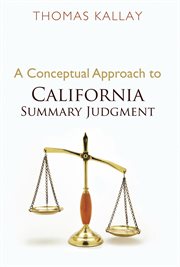Details
PUBLISHED
Made available through hoopla
DESCRIPTION
1 online resource
ISBN/ISSN
LANGUAGE
NOTES
Summary judgment is a sophisticated and important procedural device; in A Conceptual Approach to California Summary Judgment, author Thomas Kallay provides a detailed analysis and explanation of how this procedure is used in California. Kallay identifies its fundamental components and concepts and shows how these interact with each other. This study also explores the relationship of California summary judgment to other procedural devices. It discusses: direct, circumstantial, and admissible evidence; the presentation of evidence; material and ultimate facts; the burden of the moving party and opposing party; evaluation of opponents evidence; evenly balanced influences; summary adjudication; summary judgment, directed verdict, and the constitution; the burdens of production and persuasion; the appeal. Geared toward law students and lawyers, A Conceptual Approach to California Summary Judgment provides a comprehensive overview of this significant component of California law. The cornerstone of summary judgment is evidence. First, both the party moving for summary judgment and the opponent of the motion must rely on evidence. Second, the court must determine the motion based on the evidence presented. The courts have held from time to time that the parties to a motion for summary judgment must rely on evidentiary facts. This is another way of saying that the parties and the court must rely on admissible evidence. With one exception, evidence for the purposes of summary judgment is no different from evidence presented at trial
Mode of access: World Wide Web







